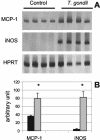Infection with Toxoplasma gondii increases atherosclerotic lesion in ApoE-deficient mice
- PMID: 15155666
- PMCID: PMC415665
- DOI: 10.1128/IAI.72.6.3571-3576.2004
Infection with Toxoplasma gondii increases atherosclerotic lesion in ApoE-deficient mice
Abstract
Toxoplasma gondii is an intracellular protozoan that elicits a potent inflammatory response during the acute phase of infection. Herein, we evaluate whether T. gondii infection alters the natural course of aortic lesions. ApoE knockout mice were infected with T. gondii, and at 5 weeks of infection, serum, feces, and liver cholesterol; aortic lesion size, cellularity, and inflammatory cytokines; and levels of serum nitrite and gamma interferon (IFN-gamma) were analyzed. Our results showed that serum cholesterol and atherogenic lipoproteins were reduced after T. gondii infection. The reduction of serum levels of total cholesterol and atherogenic lipoproteins was associated with increases in the aortic lesion area, numbers of inflammatory cells, and expression of monocyte chemoattractant protein 1 and inducible nitric oxide synthase mRNA in the site of lesions as well as elevated concentrations of IFN-gamma and nitrite in sera of T. gondii-infected animals. These results suggest that infection with T. gondii accelerates atherosclerotic development by stimulating the proinflammatory response and oxidative stress, thereby increasing the area of aortic lesion.
Figures




References
-
- Aliberti, J. C. S., F. S. Machado, J. T. Souto, A. P. Campanelli, M. M. Teixeira, R. T. Gazzinelli, and J. S. Silva. 1999. β-Chemokines enhance parasite uptake and promote nitric oxide-dependent microbiostatic activity in murine inflammatory macrophages infected with Trypanosoma cruzi. Infect. Immun. 67:4819-4826. - PMC - PubMed
-
- Binder, C. J., M. Chang, P. X. Shaw, Y. I. Miller, K. Hartvigsen, A. Dewan, and J. L. Witztum. 2002. Innate and acquired immunity in atherogenesis. Nat. Med. 8:1218-1226. - PubMed
-
- Blader, I. J., I. D. Manger, and J. C. Boothroyd. 2001. Microarray analysis reveals previously unknown changes in Toxoplasma gondii-infected human cells. J. Biol. Chem. 276:24223-27231. - PubMed
-
- Camargo, M. M., I. C. Almeida, M. E. S. Pereira, M. A. J. Ferguson, L. R. Travassos, and R. T. Gazzinelli. 1997. Glycosylphosphatidylinositol anchored mucin-like glycoproteins isolated from Trypanosoma cruzi trypomastigotes initiate the synthesis of pro-inflammatory cytokines by macrophages. J. Immunol. 158:5890-5901. - PubMed
Publication types
MeSH terms
Substances
LinkOut - more resources
Full Text Sources
Molecular Biology Databases
Research Materials
Miscellaneous

